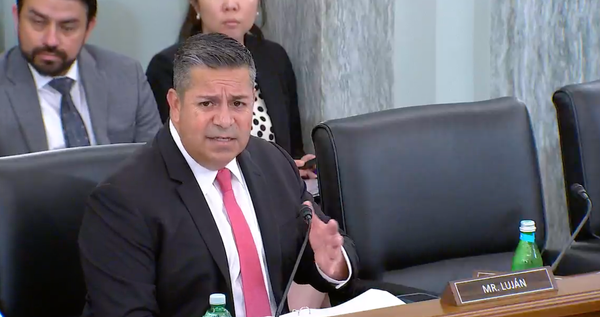Louis Peraertz: FCC’s Digital Discrimination Rules Don't Help Bridge Digital Divides
The FCC does not allow an ISP defendant to argue that its decision not to provide access to broadband was based on any substantial, legitimate, nondiscriminatory interest.

The fact that so many low-income consumers and others in hard to serve areas are on the wrong side of the digital divide is a problem that members of WISPA – The Association for Broadband Without Boundaries – have been working to address for decades.
Our Association represents more than 600 small Internet Service Providers, that use fixed wireless, fiber optic, or other broadband technologies, to provide high speed, reliable broadband service to their local communities.
These communities are in sparsely populated, rural, exurban, and other areas that larger broadband companies could not find profitable business cases to serve. The majority of our ISP members – approximately 65.5 percent – serve 2,000 or fewer residential customers, and none serves more than 250,000 subscribers. We are proud that, altogether, our members provide broadband service to millions of Americans.
During the COVID-19 pandemic, the challenges of the digital divide became more acute. In 2020 and 2021, state and local governments issued stay-at-home orders that led to dramatic surges in demand for broadband at home. To address this problem, Congress enacted the bi-partisan Infrastructure Investment and Jobs Act of 2021.
Notably, the IIJA authorized NTIA to develop the Broadband Equity, Access, and Deployment program to provide up to $41.6 billion for broadband deployment to locations that are unserved (lack access to broadband at 25 Megabits per second down (Mbps) * 3 Mbps up) or underserved (lack access to broadband at 100 * 20 Mbps).
The IIJA also included Section 60506 that directed the FCC to adopt rules “to facilitate equal access to broadband internet access service… taking into account the issues of technical and economic feasibility presented by that objective” and “prevent[] digital discrimination of access based on income level, race, ethnicity, color, religion, or national origin.”
Rulemaking to implement digital discrimination rules
In March 2022, the FCC initiated its rulemaking to implement Section 60506. In response, large and small ISPs recommended that the FCC not impose burdensome disparate impact rules. That is because onerous disparate impact rules would discourage companies from making investments necessary to connect more Americans to 100 * 20 Mbps broadband.
“Disparate impact” claims focus on the discriminatory effects of neutral policies and practices, without regard to purposeful intent. Like proving a negative, they are expensive, time consuming, and tough to defend against.
Unfortunately, the FCC did not heed that advice. In November 2023, the FCC adopted digital discrimination rules that include this definition of digital discrimination: “[p]olicies or practices, not justified by genuine issues of technical or economic feasibility, that (1) differentially impact consumers’ access to broadband internet access service based on their income level, race, ethnicity, color, religion, or national origin, or (2) are intended to have such differential impact on those classes of consumers.”
The FCC also adopted procedure rules that are unlawful and make it difficult to defend against disparate impact claims. First, the FCC’s procedure rules, are inconsistent with U.S. Supreme Court precedent, because they do not allow an ISP defendant to argue that its decision not to provide access to broadband was based on any substantial, legitimate, nondiscriminatory interest.
Instead, the FCC required that a defense to a disparate impact claim must be based on an argument that not providing access to broadband was due to technical or economic infeasibility. Second, the FCC defines technical feasibility and economic feasibility to include this standard – “reasonably achievable as evidenced by prior success by covered entities under similar circumstances.” This means an ISP would not only have to focus on its own decisions to deploy, market and price broadband service – in essence, its competitive differentiation – but also focus on and possibly copy the practices and policies that its competitors use.
FCC could improperly find liability on ISPs
Therefore, FCC could improperly find liability because a company has not copied a competitor’s path to success. Also, the FCC has not defined “prior success” or “similar circumstances,” with sufficient clarity. For these reasons, defending against such disparate impact claims would be difficult for both large and small ISPs, but particularly difficult for WISPA’s small ISP members. Third, and also contrary to Supreme Court precedent, the FCC’s rules require the defending ISP to bear the burden of proving there was no less discriminatory alternative to the deployment practice being challenged as having a discriminatory impact.
The FCC’s disparate impact rules are based on a deeply flawed interpretation of Section 60506 of the IIJA, are inconsistent with U.S. Supreme Court precedent on how to litigate and review disparate impact claims and are not supported by any formal cost-benefit analysis.
So, on February 28, WISPA filed a petition for review to overturn those rules. Our petition will be decided by the U.S. Court of Appeals for the Eighth Circuit. WISPA joined a coalition of 20 entities. The coalition filed its opening brief on April 22.
Louis Peraertz is Vice President of Policy for WISPA. This piece is exclusive to Broadband Breakfast.
Broadband Breakfast accepts commentary from informed observers of the broadband scene. Please send pieces to commentary@breakfast.media. The views expressed in Expert Opinion pieces do not necessarily reflect the views of Broadband Breakfast and Breakfast Media LLC.










